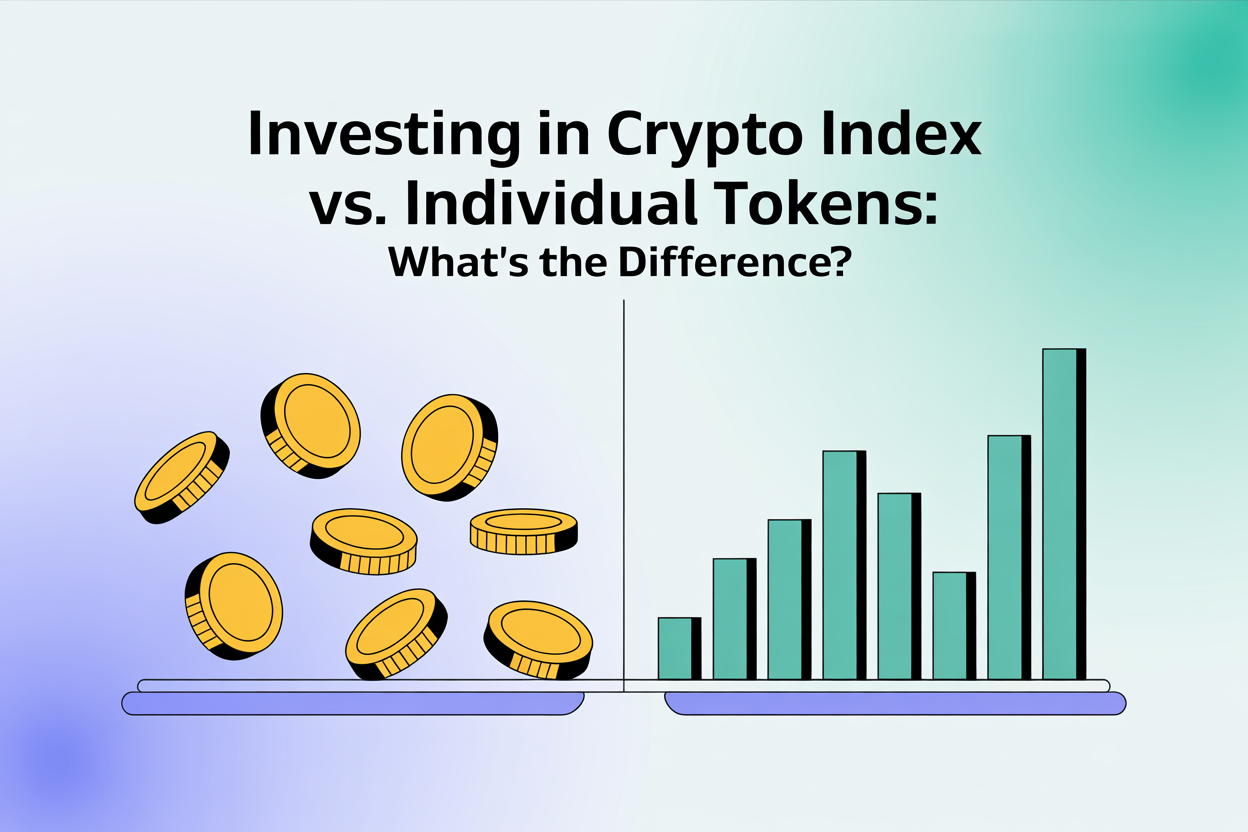Now Reading: Investing in Crypto Index vs. Individual Tokens: What’s the Difference?
- 01
Investing in Crypto Index vs. Individual Tokens: What’s the Difference?
Investing in Crypto Index vs. Individual Tokens: What’s the Difference?

Investing in the cryptocurrency market is getting more popular. Investors have many options, like a crypto index or individual tokens. Knowing the differences between these is key to smart investing.
A crypto index helps spread out investments, which can lower risk. Investing in individual tokens, on the other hand, lets you bet on specific cryptocurrencies’ growth.

Key Takeaways
- Diversification is key to managing risk in cryptocurrency investments.
- Cryptocurrency indexes offer a way to spread investment across various assets.
- Individual tokens provide the potential for significant growth.
- Understanding the differences between index and individual token investments is crucial.
- Investors should consider their risk tolerance and investment goals.
Understanding the Cryptocurrency Investment Landscape
The world of cryptocurrency is growing, offering more investment choices. This change is reshaping how people invest in digital assets and diversify their portfolios.
The Evolution of Crypto Investment Options
The crypto market has changed a lot since it started. At first, there were few places to invest. Now, there are many, like crypto indexes and specific tokens. This variety lets investors pick what fits their risk level and goals.
The Growing Importance of Strategic Asset Allocation
Strategic asset allocation is key in crypto investing. Spreading investments across different assets can lower risk and boost returns. It’s about knowing the different investment options and how to mix them for a well-rounded portfolio.
What Are Crypto Indexes?
Crypto indexes are becoming key for investors looking to spread their bets across the market. They track certain parts or the whole crypto market. This helps investors build a diverse portfolio.
Definition and Core Concepts
A crypto index is like a basket of cryptocurrencies. It lets investors tap into many digital assets with one investment. It’s similar to how stock market indexes work, like the S&P 500. The main idea is to spread out risk by not focusing on just one cryptocurrency.
Types of Crypto Indexes Available
There are many crypto indexes out there, each suited for different investment styles. Some cover a wide range of cryptocurrencies, while others focus on specific areas like DeFi tokens or privacy coins. Investors can pick indexes that match their goals and how much risk they’re willing to take. For more details, check out STOXX Digital Asset Indices.
How Crypto Indexes Are Constructed and Maintained
Creating and keeping crypto indexes involves a few steps. First, the provider picks the cryptocurrencies to include based on things like size or how liquid they are. Then, the index is weighted based on these factors. To keep the index up to date, it’s rebalanced regularly. It’s important for investors to know how these indexes are made and kept, as explained in articles comparing long-term vs short-term crypto investment strategies.
Crypto indexes make it easier to invest in the crypto market. They offer a way to diversify and possibly lower risk. By understanding how these indexes are put together and kept up, investors can make better choices for their money.
Individual Tokens Explained
Individual tokens are specific projects or assets in the cryptocurrency world. They are grouped by their function, use, and technology.
Categories of Individual Cryptocurrencies
There are several types of individual cryptocurrencies. These include:
- Payment tokens, used as a way to exchange value.
- Utility tokens, giving access to certain products or services on a blockchain.
- Security tokens, showing ownership in an asset or company.
- Governance tokens, for voting on decisions in DeFi projects.
Knowing these categories is key for token selection criteria. Each token type has its own traits and growth potential.
Token Utility and Value Propositions
The usefulness and value of individual tokens differ a lot. Some offer staking rewards, while others give governance rights or special services.
When looking at individual tokens, consider their:
- Technology and how well it scales.
- How widely they are adopted and the community support.
- The competition and their chance to change the game.
By looking at these points, investors can make smart choices. They can pick tokens that fit their investment goals.
Crypto Index vs Individual Tokens: Core Differences
When looking at cryptocurrency investments, it’s important to know the difference between crypto indexes and individual tokens. This knowledge helps investors make smart choices based on their goals and how much risk they can handle.
Diversification Profiles
Crypto indexes spread out investments by following a group of cryptocurrencies. This can lower risk. On the other hand, individual tokens are just one asset, making them more prone to big swings. For example, a crypto index might include big names like Bitcoin and Ethereum, plus smaller ones, giving a wide view of the market.
Risk Exposure Comparison
Crypto indexes usually have less risk because they’re spread out. But, individual tokens can be riskier since they’re tied to just one project. It’s important for investors to think about how much risk they can handle before choosing.
Management Requirements
Handling a portfolio of individual tokens needs more effort and research than a crypto index. Crypto indexes are managed by experts who keep the index balanced. This makes them easier to invest in. For more on how to invest in cryptocurrency, check out this resource.
In summary, picking between crypto indexes and individual tokens depends on what you need, how much risk you’re okay with, and how you like to manage your investments. Looking at these factors is crucial for a good investment strategy.
Advantages of Crypto Index Investing
Investors looking for an easy way to get into cryptocurrency might find crypto indexes appealing. These indexes let people dive into the crypto market without picking and choosing each token themselves.
Built-in Diversification Benefits
One big plus of crypto index investing is the built-in diversification it offers. Indexes spread out investments across many cryptocurrencies. This helps lower the risk tied to the ups and downs of single tokens.
This diversification can make for a steadier investment ride. The index’s performance isn’t tied to just one cryptocurrency.
Reduced Research Burden
Investing in crypto indexes also reduces the research burden on investors. Instead of digging into each cryptocurrency, investors can trust the index’s selection and weighting. This is great for newcomers or those short on time for research.
Lower Emotional Decision-Making
Also, crypto index investing can cut down on emotional decision-making. By investing in a diversified index, investors are less likely to act on the price swings of single tokens. This leads to a more steady investment strategy, as emotional reactions to market changes are lessened.
Drawbacks of Crypto Index Investing
Investing in crypto indexes comes with its own set of challenges. These include limited upside potential and concerns about the composition of the index. It’s important to know the downsides of this strategy.
Limited Upside Potential
One major drawback is the limited upside potential. Investing in a diversified index might mean missing out on big gains from a single, top-performing token. This is because the index’s performance is averaged across all its assets, which can limit the gains.
Index Composition Concerns
The composition of the crypto index is another concern. The index’s strength depends on its assets. If it focuses too much on one sector or type of cryptocurrency, it may not offer the diversification investors seek. The way the index is built and maintained also affects its performance.

Fee Structures and Costs
Investors should also consider the fees involved in crypto index investing. Management fees, rebalancing costs, and other expenses can reduce returns. It’s key to understand these costs and include them in investment decisions.
Knowing these drawbacks helps investors decide if crypto index investing fits their strategy and risk level.
Benefits of Individual Token Investing
Investing in individual tokens has many benefits. It can lead to higher returns and focus on new technologies. This way, investors can benefit from the growth of certain cryptocurrencies, possibly earning big profits.
Higher Growth Potential
Investing in specific tokens can offer higher growth potential than other strategies. By choosing certain cryptocurrencies, investors can dive into new trends and technologies. This could result in big gains.
The secret to success is effective token selection criteria. This means looking at market demand, competition, and tech advancements.
Targeted Exposure to Specific Technologies
Investing in individual tokens lets investors focus on specific technologies and uses. This way, they can benefit from new projects and technologies, like DeFi or NFTs.
By picking specific tokens, investors can build a portfolio that fits their goals and risk level. This makes for a more nuanced cryptocurrency comparison.
Greater Control Over Investment Decisions
Investing in individual tokens gives investors greater control over their decisions. By choosing certain cryptocurrencies, they can align their portfolio with their strategy and risk management.
This control also lets investors react fast to market changes. They can adjust their portfolios to lessen the effect of market ups and downs.
Challenges of Individual Token Investing
Investing in individual tokens can be tempting, but it comes with big challenges. To manage your crypto investments well, you need to know the market and its risks. One major worry is losing a lot of money because of price changes.
Increased Volatility and Risk
Individual tokens often have high price swings. This makes it hard for investors to keep their money safe, mainly when prices drop. Efficient risk management strategies are key to avoid big losses.
Research and Due Diligence Requirements
Investing in individual tokens needs a lot of research and careful planning. You must keep up with market trends, project updates, and risks. This takes a lot of time and effort to stay ahead of the curve.
Psychological Challenges
The crypto market is full of ups and downs, with prices changing fast. Investors face emotional stress from these changes. A robust investment strategy and a long-term view can help deal with these feelings.
Spreading out your crypto investments is crucial for managing risk. Knowing the challenges of investing in individual tokens helps you make better choices. It also helps you develop strategies for the complex world of cryptocurrencies.
How to Evaluate Crypto Indexes Before Investing
The world of cryptocurrency is always changing. For investors looking to spread out their money, checking crypto indexes is key. These indexes let you invest in many cryptocurrencies at once. But, not all indexes are the same.
Index Methodology Assessment
First, you need to understand how a crypto index works. Look into how it’s made and kept up.
Weighting Mechanisms and Rebalancing Frequency
The weighting mechanism shows how each asset is included. You might see market cap or equal weighting. Knowing how often the index changes is also important.
Inclusion and Exclusion Criteria
It’s important to know why certain assets are in or out of the index. This can change how well the index does. Look for clear, fair rules.
Performance Metrics to Consider
Looking at a crypto index’s past performance is crucial. Check its returns, how volatile it is, and how it does in bad times. Comparing it to others and the market can show how it stacks up.
Provider Reputation and Track Record
The reputation of the index provider matters a lot. Look for providers known for being reliable, open, and sticking to their methods. A trusted provider means a better index for you.

By looking at these points, you can choose a crypto index wisely. It’s about finding the right mix of risk and reward for your goals.
Selecting Individual Tokens: A Systematic Approach
Choosing individual tokens wisely can help reduce risks and increase gains in the crypto market. Investors must look at several factors to match their investment goals.
Fundamental Analysis Framework
Using a fundamental analysis framework is key to understanding a token’s true value. It involves checking different aspects of the token and its project.
Team Assessment and Technology Evaluation
It’s important to check the project team, their skills, and the token’s technology. A skilled team can greatly boost a token’s success chances.
Tokenomics and Market Positioning
Tokenomics is about a token’s economic design. Knowing this and the token’s market position helps investors see its growth potential.
Technical Analysis Considerations
Technical analysis looks at past price data and patterns to forecast future prices. Investors should look at technical indicators like trends and momentum when picking tokens.
- Identify trends and patterns in price charts
- Use indicators like RSI and MACD to gauge momentum
- Analyze trading volumes to confirm price movements
Red Flags to Watch For
When picking tokens, watch out for red flags like:
- Lack of transparency in project details or team backgrounds
- Unrealistic promises or overhyped claims about the project
- Poor community engagement or little developer activity
Building a Hybrid Strategy: Combining Indexes and Individual Tokens
A hybrid investment strategy combines crypto indexes with individual tokens. This mix offers a balanced way to manage digital asset allocation. It makes your portfolio stronger and more resilient.
Core-Satellite Portfolio Construction
The core-satellite approach divides your portfolio into two parts. The core is usually a diversified investment, like a crypto index. It provides stability and broad market exposure. The satellite part is for individual tokens, aiming for specific assets with high growth potential.
This method helps manage risk while aiming for big returns. By focusing more on the core, you get a stable base. The satellite investments can bring in big gains.
Allocation Percentages and Rebalancing
Choosing the right mix between core and satellite depends on several things. These include your risk tolerance, investment goals, and market conditions. A common mix is 70-80% core and 20-30% satellite.
Regular rebalancing is key to keep your mix right. As markets change, rebalancing keeps your portfolio in line with your strategy. It helps manage crypto investments well.
Step-by-Step Guide to Implementing Your Crypto Investment Strategy
Starting a crypto investment strategy needs a clear plan. It’s important to understand each step to manage your investments well. Breaking down the task into smaller parts helps a lot.
Setting Up Accounts and Security Measures
To start investing in crypto indexes or tokens, you must first set up a secure account. This means:
- Creating an account and finishing any needed verification steps
- Setting up strong security, like two-factor authentication (2FA) and unique passwords
- Learning about the platform’s fees and rules
Keeping your investments safe is key. Think about using hardware wallets for extra protection against hackers and thieves.
Executing Your First Index and Token Investments
After setting up your account and making it secure, you can start investing. Here’s what to do:
- Decide how much to invest in indexes versus individual tokens, based on your strategy
- Choose the indexes or tokens you want to invest in, using your research
- Place your orders on the platform, picking from market, limit, or other types
It’s important to keep an eye on your investments. Be ready to adjust your portfolio to keep your asset mix right.

Investment Platforms and Tools for Crypto Indexes and Tokens
The rise of cryptocurrency comparison tools has made it easier for investors to navigate the complex landscape of digital assets. Now, investors can make more informed decisions about their digital asset allocation.
Centralized Exchange Options
Centralized exchanges (CEXs) are a popular choice for investors. They offer a user-friendly interface and a wide range of cryptocurrencies. This includes major tokens and altcoins.
Some key features of CEXs include:
- High liquidity: Ensuring that investors can easily buy and sell cryptocurrencies.
- Advanced trading tools: Providing features such as stop-loss orders and margin trading.
- User-friendly interface: Making it easier for new investors to navigate the platform.
Examples of popular CEXs include Coinbase, Binance, and Kraken. When choosing a CEX, investors should consider fees, security measures, and available trading pairs.
Decentralized Finance Solutions
Decentralized finance (DeFi) solutions offer an alternative to traditional CEXs. They provide a more decentralized and autonomous way to manage cryptocurrency investments. DeFi platforms use blockchain technology and smart contracts for lending, borrowing, and trading.
Some benefits of DeFi solutions include:
- Increased security: Through the use of smart contracts and decentralized governance.
- Greater transparency: Allowing investors to track their investments and transactions.
- Autonomy: Enabling investors to manage their investments without intermediaries.
Examples of DeFi platforms include Uniswap and Compound. When exploring DeFi solutions, investors should be aware of the potential risks, such as smart contract vulnerabilities and market volatility.
Tax Implications and Regulatory Considerations
It’s important for investors in the cryptocurrency market to know about taxes and rules. As the crypto world grows, investors need to understand their tax duties and follow the rules. This helps them make smart choices with their investments.
Tax Treatment Differences
The way taxes work for crypto indexes and single tokens is different. For example, crypto indexes might be easier to report taxes for because they are seen as one thing. On the other hand, individual tokens need to be tracked and reported separately, which can be harder. It’s a good idea for investors to talk to tax experts to figure out what they need to do.
Navigating Regulatory Compliance
Understanding the rules for crypto investments is key. Investors must follow laws like anti-money laundering (AML) and know-your-customer (KYC). To manage their crypto well, they need to keep up with rule changes and adjust their plans as needed.
Risk Management Strategies for Crypto Investors
The cryptocurrency market is very volatile. This means investors need to use smart risk management. It helps protect their money and make good choices in a fast-changing world.
Position Sizing and Portfolio Allocation
Managing risk starts with the right position sizing and portfolio allocation. Investors should figure out the best mix of assets for their risk level and goals. This is key to keeping their investments safe.
- Know your risk tolerance and how long you can invest.
- Spread your money across different crypto assets.
- Keep checking and tweaking your asset mix.
Hedging Techniques and Stop-Loss Strategies
Hedging and stop-loss strategies are crucial for avoiding big losses. They help investors protect their investments in a shaky market. There are many ways to hedge and limit losses.
- Set stop-loss orders to sell when prices drop too low.
- Use options and futures to protect against losses.
- Spread your investments to avoid being too exposed to one asset.
Crypto portfolio diversification is vital for risk management. By investing in different assets, you can lessen the impact of market ups and downs. Managing crypto investments well means planning carefully and keeping a close eye on your portfolio.

Determining the Right Approach for Your Financial Goals and Risk Tolerance
When you’re looking at your investment strategy, think about your financial goals and how much risk you can handle. Investing in crypto indexes and individual tokens each have their own pros and cons. These were covered in this article.
Choosing between crypto indexes and individual tokens depends on your financial goals and risk comfort. If you want diversification and lower risk, crypto indexes might be better. But, if you’re after higher growth and are okay with more risk, individual tokens could be the way to go.
Doing a deep dive into your investment strategy is important. Think about how long you can invest, how much risk you’re comfortable with, and how cryptocurrency fits into your portfolio. By considering these, you can decide if a crypto index, individual tokens, or a mix is right for you.
Knowing the difference between crypto indexes and individual tokens is crucial. It helps you make a choice that fits your needs and goals. This way, you can navigate the complex world of cryptocurrency effectively.
FAQ
What is the main difference between investing in a crypto index and individual tokens?
Investing in a crypto index spreads your money across many cryptocurrencies. This can lower your risk. On the other hand, picking individual tokens can be riskier because you’re betting on just one or a few.
How do I choose between a crypto index and individual tokens for my investment portfolio?
Your choice depends on what you want to achieve and how much risk you’re willing to take. Crypto indexes are safer, offering a wide range of market exposure. But, individual tokens might offer bigger gains, though they’re riskier.
What are the benefits of using a crypto index for investment?
Crypto indexes make investing easier by spreading your money across many coins. They also save you from having to do a lot of research. This way, you can invest in many coins without picking each one yourself.
How do crypto indexes handle the addition or removal of tokens?
Crypto indexes follow rules to add or remove coins. These rules might look at market size, how easy it is to trade, or other factors. The index provider usually outlines these rules.
Can I invest in both crypto indexes and individual tokens?
Yes, many people mix both crypto indexes and individual tokens in their portfolios. This mix can balance your investments. It lets you enjoy the benefits of diversification while also targeting specific coins.
What are the key considerations for evaluating the performance of a crypto index?
Look at the index’s method, how it weights its coins, and its past performance. Also, check the fees and the provider’s reputation. These factors can help you understand the index’s value.
How do tax implications differ between crypto indexes and individual tokens?
Taxes on crypto indexes and individual tokens depend on where you live and the local tax laws. Both are usually taxed on capital gains. But, how dividends, interest, or other income are taxed can vary.
What risk management strategies are effective for crypto investments?
Good strategies include setting the size of your investments, spreading them out, using hedging, and setting stop-loss limits. These can help protect your money in the unpredictable crypto market.

















